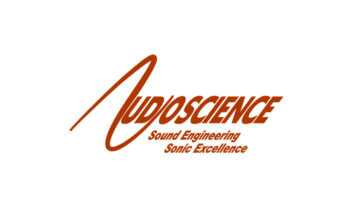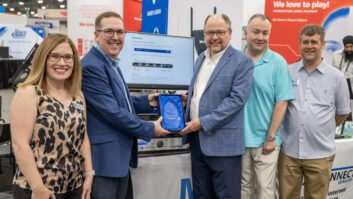Digital audio quickly has evolved into a bewildering array of standards, formats, bit rates and connectors. Typically, tying together satellite feeds, in-house production, and on-air automation creates a patchwork of ad-hoc and often undocumented fixes.
The AudioScience ASI6114 audio adapter card is designed to bring this fragmentation together into a unified solution. Think of it as acting as a universal translator to work with analog or digital signals across a range of formats, including MPEG, PCM and MP3 and the various flavors these come in. For shops that do the dance of mixing and matching these formats, the ability of the ASI6114 to accomplish this makes for elegant simplicity.
Part of a series
The ASI6114 is part of a series of cards that offer a number of combinations of I/O and format compatibility combinations. For those familiar with the line, this replaces the ASI4113.
Product CapsuleThumbs Up
Powerful DSPs to handle processor-intensive operation
Scalable to handle very large setups
Easy to install and configure
Thumbs Down
Nearly nonexistent documentation
Price: $2,995
For more information from AudioScience, contact the company in Delaware at (302) 324-5333 or visit www.audioscience.com.
It has one mono/stereo record channel matched with four stereo/eight mono outputs. The DSPs handle 16- and 32-bit PCM, MPEG Layer 2, MP3 and DolbyAC2 (playback only) audio formats. Analog sample rates range from 8 to 48 kHz while digital signals operate at 32, 44.1 and 48 kHz.
The kit contains a PCI card, two cable snakes (one each for analog and digital connectors) and connector cables to attach the cable snakes directly to the card. The PCI card is a 10-inch form-factor taking up about two-thirds the length of the case.
It is powered by the Texas Instruments TMS320C6711 VLIW DSP chip operating at 150 MHz and has two external connectors.
The analog cables go through a SCSI II-type Mini50 connector while the digital side attaches to a Mini26. Intermediary cables join these to Centronics 50 adapters that then connect to the cable snakes. Both analog and digital cables terminate in XLRs.
The digital cables are software-selectable between AES/EBU and S/PDIF and include a word clock synch I/O. Individual cards are designed to work in tandem with up to eight other cards so that this solution scales to fit all but the most complex broadcast and entertainment applications. The cards have both WAV and Linux drivers. A Windows WDM driver is in beta.
Easy install
Installing the demo card was easy although the instruction manual for this package was minimal. The step-by-step details for installation were thorough but documentation on the mixing application was nonexistent.
After tinkering with it, much of what is involved is self-explanatory. Still, some of us like to have it written down to make sure that we are traveling the right road.
I did not find myself wandering off into any dead ends. Installing it into a Windows 2000 workstation was simple. Plug and play identified new hardware and I directed it manually to find the appropriate drivers downloaded from the AudioScience site.
The mixer application, too, is self-explanatory. The same application is shared by all AudioScience cards. The aim of the program is not to serve as an active mixing console. Rather it establishes the layout to match the particular physical environment it is installed in. There is really not that much to it – assigning levels to specific line-outs and the like.
The nitpicking around formats and bit rates is missing as it is automatically handled by the card. This just makes sure that the right signal is going into the right connector with the correct mono/stereo setting and levels adjusted properly. Even with zero documentation, the functionality was clear.
The ASI6114 is designed to ingest audio through the single input and send that out – along with multiple additional streams – through the four stereo and eight mono outputs. The greatest challenge for this is not in taking audio in, but outputting a lot of channels, each requiring significant processing. This can be enormously DSP-intensive.
Crunching the maximum of eight mono streams of MP3 files into various formats is a drain on resources and can bog the processing down. The best way to handle such heavy-duty needs is to buy an additional card to distribute the task.
In addition to making easy work of the difficult task of matching audio formats, the AudioScience cards are soon to gain additional functionalities through what the company calls TSX – time scaling technology.
Streams can be compressed in real time up to 20 percent. At full-bore, that is about enough to squeeze 29 hours in a broadcast day. Company literature claims that the TSX algorithms do not change the pitch or introduce the usual glitches and distortion artifacts. These added features will come from a driver update, allowing developers to add TSX to their applications.
The AudioScience ASI6114 meets the needs for simplifying today’s tangle of audio formats. Designed to work with popular automation systems (Prophet, Scott, BSI, ENCO, etc.), this can simplify the confusion that now defines audio engineering.







